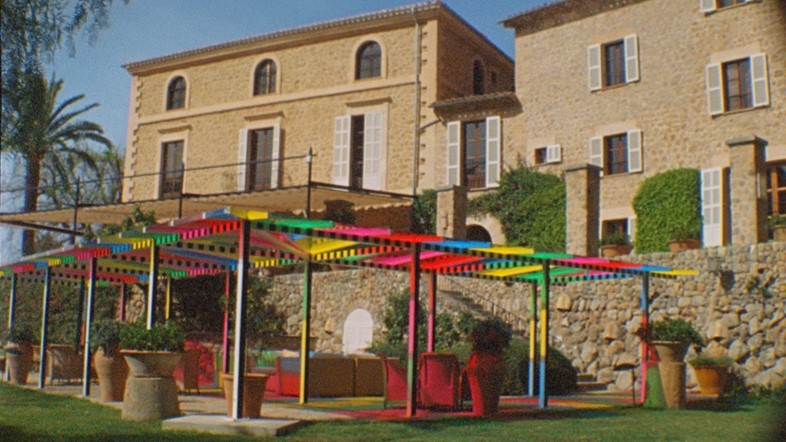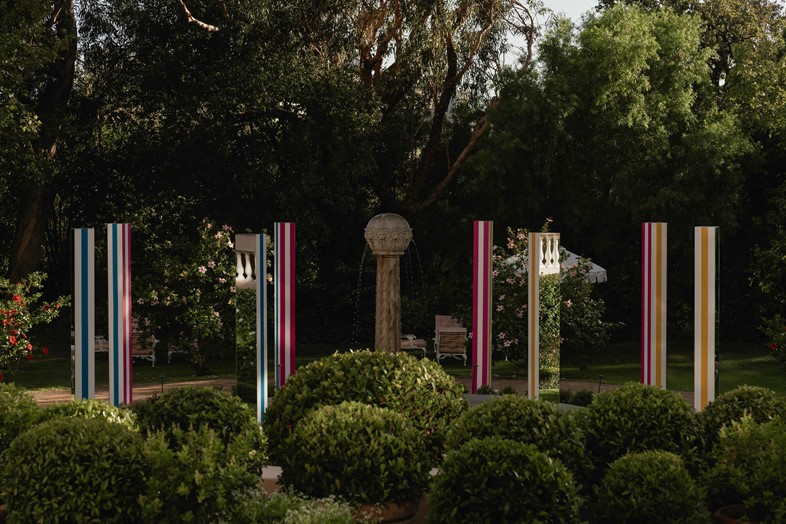French artist Daniel Buren talks us through his new site-specific commissions for Belmond, which are transforming six unique properties around the world
If Marcel Duchamp invented conceptual art in the 1910s, a stream of American artists in the 1960s repurposed the idea of the artwork going beyond its form to become an idea, and establishing a new way of making and thinking about art. As a product of a NYC-centric avant-garde movement, conceptual art was formed as a reaction to escape formalism, a tendency outlined in the works of Sol Lewitt, Lawrence Weiner, Yoko Ono, Joseph Kosuth and more.
French artist Daniel Buren has always rejected the imperative of form, making work that exists in public contexts, and that adopts repetition and seriality to convey the idea that a painting, ultimately, is a concept itself. Renowned for his stripes works, the stylistic signature that today has become an emblem of contemporary culture, Buren intended this as a gesture to detach from figurative painting as much as possible, intervening on flat, coloured surfaces only by applying white duct tape on them.
An artist who has a deliberately anti-studio practice, Buren has extensively produced site-specific works – or, in-situ, as he calls them – that respond to the surrounding environment and that involve the viewers’ participation as a key element to activate them. Commissioned by Belmond in partnership with Galleria Continua, the annual project entitled MITICO (now in third running year) features six unique in-situ works by Daniel Buren in locations around the world.

Three-metre-pillars, which alternate between mirrors and stripes, surround the garden fountain at Cape Town’s Mount Nelson hotel; a similar approach extends to the intervention at Hotel Cipriani in Venice, where Buren focused on the fountain to create a circular structure. At Castello di Casole, Buren has created three “portals” – a circle, a square, and a triangle – that frame the landscape of the Tuscan countryside. In Mallorca, at La Residencia, a translucent pergola filters light and colour over the hotel’s terrace, while the facade of Rio De Janeiro’s Copacabana Palace is adorned by coloured vinyl records filtering lights and shapes. For Villa San Michele, in Florence, Buren has conceived a work that takes over the roof of the hotel’s bar.
Below, AnOther sat down with the artist to discuss his work, legacy, and approach to this specific project.
Federico Sargentone: Your work explores the possibilities of painting beyond its traditional format. What do you think a painting can be today?
Daniel Buren: There have always been very few true painters. I stopped painting because I saw certain limits and found it more interesting to experiment with new spaces and ways of working that don’t inherently lead to making a tableau. I abandoned the idea of painting as I knew it when I started seriously working as a painter in the 1970s. So yes, I gave it up and I haven’t picked it up again since. And I know there are people who think that what I do is painting, but that’s their opinion and not mine.
“Ultimately, it’s the essence of the place itself that dictates what will unfold there” – Daniel Buren
FS: With the series Affichages sauvages that you started in the late 60s, you distributed your work in urban, public settings, that the audience could encounter and experience with surprise. The same happens with Haltes Colorées, travaux in situ pour MITICO, 2023-2024, your new commissions with Belmond. What’s the role of the public setting in your process?
DB: From the moment I started working “outside” I realised that it was a field with new possibilities, which is almost always renewed each time you approach a new place. Working outside started as an economic consideration: I couldn’t find a studio. So I started questioning why artists need a studio, which can easily become completely interwoven into the career and work of virtually every artist. I realised that it was interesting to question this habit. And so, the discovery of what was happening, which had nothing to do with what you can do in a studio was a real challenge for me.
FS: How was it for you to engage with the heritage of these historic locations, and reinterpret them in a contemporary way with Belmond as a partner?
DB: Each time the work is different, but my approach is always the same. That is, I’m invited to a place X. This place already holds certain answers. But generally speaking, I make a work, but ten others could have been done. That’s almost always the case, which reinforces my opinion that working in a specific place does open a lot of doors because that place is going to bring up a lot of questions, and a lot of solutions.
For this specific project, the idea was that there were several hotels, but they were all different. What brings all the Belmond properties together is their exceptional locations. They’re not necessarily historic sites, but they’re always exceptionally well-located.

FS: What drives you to keep making work?
DB: As the French saying goes, “It’s the opportunity that makes the thief,” and that deeply resonates with me. Everything feels wide open, and that’s what excites me. When people ask me about which museum I’d like to exhibit in, or if there’s a place I dream of being invited to, I don’t have an answer. I don’t dwell on hypotheticals. It’s only when I’m actually invited somewhere that I begin to contemplate what I might create in that space. I prefer to let reality guide me.
With this project with Belmond, when we visited these places a year ago to brainstorm ideas, it felt like stepping onto the moon – utterly unfamiliar territory. But gradually, as we envisioned a cohesive theme for these prestigious hotels in extraordinary locations, things started to take shape. Ultimately, it’s the essence of the place itself that dictates what will unfold there.
